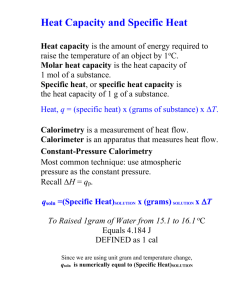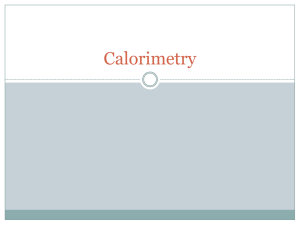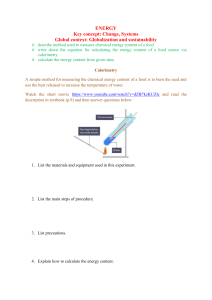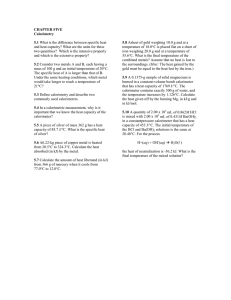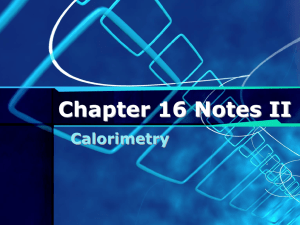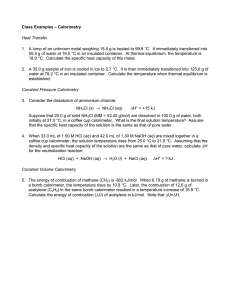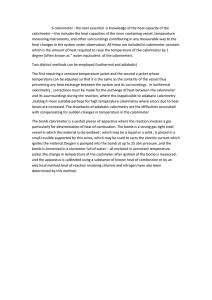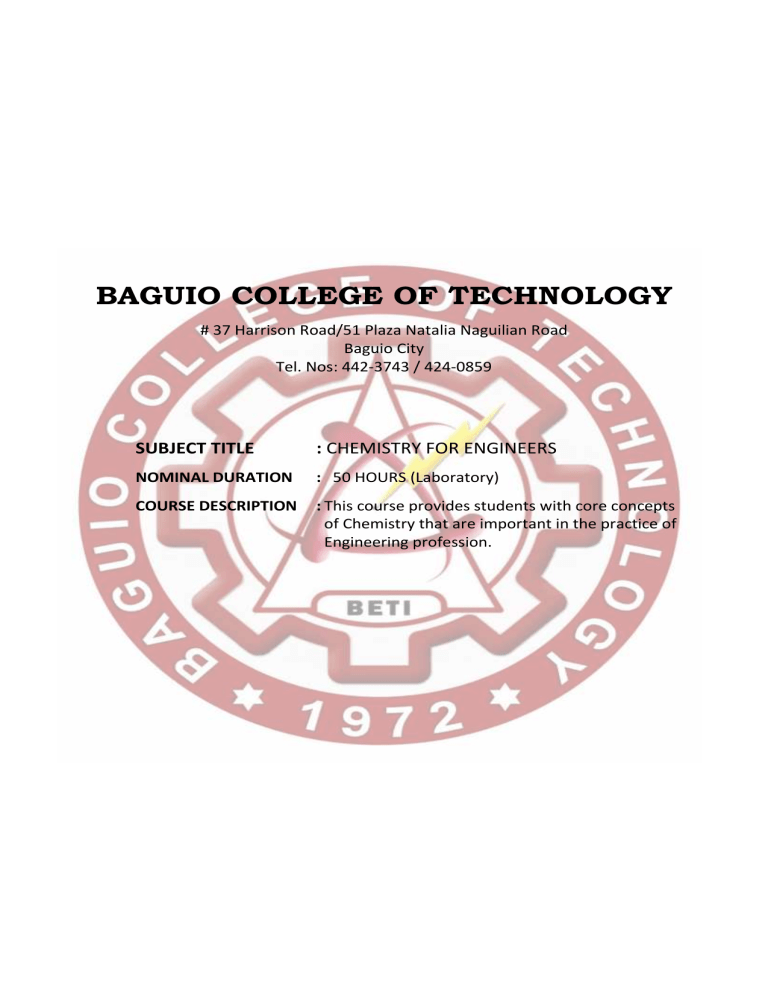
BAGUIO COLLEGE OF TECHNOLOGY # 37 Harrison Road/51 Plaza Natalia Naguilian Road Baguio City Tel. Nos: 442-3743 / 424-0859 SUBJECT TITLE : CHEMISTRY FOR ENGINEERS NOMINAL DURATION : 50 HOURS (Laboratory) COURSE DESCRIPTION : This course provides students with core concepts of Chemistry that are important in the practice of Engineering profession. BAGUIO COLLEGE OF TECHNOLOGY Baguio City, Philippines MODULE TITLE : Calorimetry MODULE NO :1 NOMINAL DURATION : 5 Hours – August 24 – 29, 2020 LEARNING OBJECTIVES: At the end of this module, the students should be able to: a. explain the concept and technique of calorimetry; b. calculate related properties using typical calorimetry data; and c. describe a simple calorimeter and how does it function. MODULE CONTENT: Calorimetry is the process of measuring the amount of heat released or absorbed during a chemical reaction. By knowing the change in heat, it can be determined whether or not a reaction is exothermic (releases heat) or endothermic (absorbs heat). Calorimetry is frequently performed in order to determine the heat of reaction or the heat of fusion or the heat of dissolution or even the specific heat capacity of a metal. Calorimetry also plays a large part of everyday life, controlling the metabolic rates in humans and consequently maintaining such functions like body temperature. In humans, metabolism is typically measured in Calories per day. A nutritional calorie (Calorie) is the energy unit used to quantify the amount of energy derived from the metabolism of foods; one Calorie is equal to 1000 calories (1 kcal), the amount of energy needed to heat 1 kg of water by 1 °C. Calorimeters A calorimeter is a device used to measure the quantity of heat transferred to or from an object. It is a coffee cup (Styrofoam cup) calorimeter - usually filled with water. The more sophisticated cases include a lid on the cup with an inserted thermometer and maybe even a stirrer. A calorimeter laboratory set-up The assumption behind the science of calorimetry is that the energy gained or lost by the water is equal to the energy lost or gained by the object under study. BCT LEARNING MODULE 2020-2021 1 BAGUIO COLLEGE OF TECHNOLOGY Baguio City, Philippines If an attempt to determine the specific heat of fusion of ice using a coffee cup calorimeter, then the assumption is that the energy gained by the ice when melting is equal to the energy lost by the surrounding water. It is assumed that there is a heat exchange between the ice and the water in the cup and that no other objects are involved in the heat exchanged. The quantity of energy gained or lost is given by the equation, Q = mwater•Cwater•ΔTwater ; Where Cwater is 4.18 J/g/°C. So if the mass of water and the temperature change of the water in the coffee cup calorimeter can be measured, the quantity of energy gained or lost by the water can be calculated. The Styrofoam in a coffee cup calorimeter reduces the amount of heat exchange between the water in the coffee cup and the surrounding air. The value of a lid on the coffee cup is that it also reduces the amount of heat exchange between the water and the surrounding air. The more that these other heat exchanges are reduced, the more true that the above mathematical equation will be. Any error analysis of a calorimetry experiment must take into consideration the flow of heat from system to calorimeter to other parts of the surroundings. And any design of a calorimeter experiment must give attention to reducing the exchanges of heat between the calorimeter contents and the surroundings. Bomb Calorimetry A cheap Styrofoam cup and a thermometer is not appropriate for a commercial food manufacturer to determine the Calorie content of their products. Chemists often use a device known as a bomb calorimeter to measure the heat exchanges associated with chemical reactions, especially combustion reactions. Having little to nothing to do with bombs of the military variety, a bomb calorimeter includes a reaction chamber where the reaction (usually a combustion reaction) takes place. The reaction chamber is a strong vessel that can withstand the intense pressure of heated gases with exploding. The caloric content of foods can be determined by using bomb calorimetry; that is, by burning the food and measuring the energy it contains. A sample of food is weighed, mixed in a blender, freeze-dried, ground into powder, and formed into a pellet. The pellet is burned inside a bomb calorimeter, and the measured temperature change is converted into energy per gram of food. The chamber is typically filled with mostly oxygen gas and the fuel. An electrical circuit is wired into the chamber in order to electrically ignite the contents in order to perform a study of the heat released upon combustion. The reaction chamber is surrounded by a jacket of water with a thermometer inserted. The heat released from the chamber warms the water-filled jacket, allowing a scientist to determine the quantity of energy released by the reaction. BCT LEARNING MODULE 2020-2021 2 BAGUIO COLLEGE OF TECHNOLOGY Baguio City, Philippines Today, the caloric content on food labels is derived using a method called the Atwater system that uses the average caloric content of the different chemical constituents of food, protein, carbohydrate, and fats. The average amounts are those given in the equation and are derived from the various results given by bomb calorimetry of whole foods. The carbohydrate amount is discounted a certain amount for the fiber content, which is indigestible carbohydrate. To determine the energy content of a food, the quantities of carbohydrate, protein, and fat are each multiplied by the average Calories per gram for each and the products summed to obtain the total energy. Constant Pressure Calorimetry In order to measure the heat of a reaction, the reaction must be isolated so that no heat is lost to the environment. This is achieved by use of a calorimeter, which insulates the reaction to better contain heat. Coffee cups are often used as a quick and easy to make calorimeter for constant pressure. More sophisticated bomb calorimeters are built for use at constant volumes. Constant Volume Calorimetry Constant Volume (bomb) calorimetry, is used to measure the heat of a reaction while holding volume constant and resisting large amounts of pressure. Although these two aspects of bomb calorimetry make for accurate results, they also contribute to the difficulty of bomb calorimetry. Here, the basic assembly of a bomb calorimeter will be addressed, as well as how bomb calorimetry relates to the heat of reaction and heat capacity and the calculations involved in regards to these two topics. Differential Scanning Calorimetry Differential scanning calorimetry is a specific type of calorimetry including both a sample substance and a reference substance, residing in separate chambers. While the reference chamber contains only a solvent, the sample chamber contains an equal amount of the same solvent in addition to the substance of interest, of which the ΔH is being determined. The ΔH due to the solvent is constant in both chambers, so any difference can be attributed to the presence of the substance of interest. BCT LEARNING MODULE 2020-2021 3 BAGUIO COLLEGE OF TECHNOLOGY Baguio City, Philippines Determining the Heat of Reaction The amount of heat that the system gives up to its surroundings so that it can return to its initial temperature is the heat of reaction. The heat of reaction is just the negative of the thermal energy gained by the calorimeter and its contents (qcalorimeter ) through the combustion reaction. Formulas: (equation 1) ΔH = qV +ΔngRT (where Δng, change of moles in gas reaction) If the constant volume calorimeter is set up the same way as before, (same steel bomb, same amount of water, etc.) then the heat capacity of the calorimeter can be measured using the following formula: (equation 2) qrxn = −qcalorimeter (equation 3) qcalorimeter = qbomb +qwater (equation 4) qcalorimeter = (heat capacity of calorimeter)×ΔT Calorimetry Problem Solving Example Maria Claro was assigned to determine the experimental value for the heat of fusion of ice. She dry and mass out 36.9 gram of ice and place it into a coffee cup with 80 g of water at 45.6°C. She placed a lid on the coffee cup and insert a thermometer. After several minutes, the ice has completely melted and the water temperature has lowered to 12.3°C. What is her experimental value for the specific heat of fusion of ice? The basis for the solution to this problem is the recognition that the quantity of energy lost by the water when cooling is equal to the quantity of energy required to melt the ice. In equation form, this could be stated as Qice = -Qcalorimeter (The negative sign indicates that the ice is gaining energy and the water in the calorimeter is losing energy.) Here the calorimeter (as in the Qcalorimeter term) is considered to be the water in the coffee cup. Since the mass of this water and its temperature change are known, the value of Qcalorimeter can be determined. Solution: Qcalorimeter = m•C•ΔT Qcalorimeter = (80 g)•(4.18 J/g/°C)•(12.3°C - 45.6°C) Qcalorimeter = -11,1135.52 J The negative sign indicates that the water lost energy. The assumption is that this energy lost by the water is equal to the quantity of energy gained by the ice. So Qice = +11,1135.52 J. (The positive sign indicates an energy gain.) This value can be used with the equation from the previous page to determine the heat of fusion of the ice. Qice = mice•ΔHfusion-ice +11,1135.52 J = (36.9 g)•ΔHfusion-ice ΔHfusion-ice = (+11,1135.52 J)/(36.9 g) ΔHfusion-ice = 3,011.80 J/g BCT LEARNING MODULE 2020-2021 4 BAGUIO COLLEGE OF TECHNOLOGY Baguio City, Philippines EVALUATION/ASSESSMENT/PERFORMANCE TASK: NAME:_________________________________ STRAND & YEAR: ________________________ DATE ACCOMPLISHED:____________________ SCORE: NOTE: Please submit this part on or before AUGUST 29, 2020. I. MATCHING TYPE. Match the definitions/descriptions on column A to its’ corresponding term/concept on column B. Write the letter of the correct answer before each test item. A ______1. Used to determine the caloric content of food products ______2. A type of calorimetry that uses a reference substance and a sample substance ______3. A device used to measure the heat transferred to or from an object ______4. A process used to determine the heat absorbed or released in a chemical reaction ______5. A type of calorimetry that usually uses Styrofoam cup to contain the heat better ______6. A product of a bomb calorimetry which is burned to determine the energy per gram contained in a food product ______7. A chemical reaction that absorbs heat, and decreases the temperature of the solution ______8. The formula used to measure the quantity of energy lost or gained in a reaction/solution ______9. An instrument used in a calorimeter that measures the temperature of the liquid in the inner vessel of a calorimeter. ______10. A chemical reaction that releases heat, thereby increases the temperature of the solution B A. constant pressure calorimetry B. calorimetry C. calorimeter D. differential scanning calorimetry E. bomb calorimetry F. pellet G. endothermic H. Q = mwater x Cwater x ΔTwater I. thermometer J. exothermic K. ΔH = qV +ΔngRT ASSIGNMENT: Do an advance reading on the next topic, Heat of Combustion. REFERENCES: Brown, Lawrence and Holme, Thomas A. (2011). Chemistry for Engineering Students. Second Edition. Belmont, CA: Brooks, Cole/Cengage Learning. Libretexts Org. (Aug 16, 2020). Calorimetry. Retrieved from https://chem.libretexts.org/Bookshelves/Physical_and_Theoretical_Chemistry_Textbook_Maps/ Supplemental_Modules_(Physical_and_Theoretical_Chemistry)/Thermodynamics/Calorimetry Calorimeters and Calorimetry. Retrieved from https://www.physicsclassroom.com/class/thermalP/Lesson-2/Calorimeters-and-Calorimetry Electrochemical energy. Retrieved from https://courses.lumenlearning.com/chemistryformajors/chapter/calorimetry/ Differential Scanning Calorimetry (DSC). Retrieved from https://www.skz.de/en/research/technicalfacilities/pruefverfahrenl/thermischeeigenshaftenl/4856.Differential-Scanning-Calorimetry.html Prepared by: MS. SAMANTHA M. QUIAMBAO BCT LEARNING MODULE 2020-2021 5
